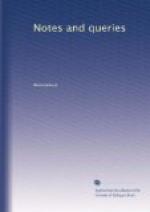“Saggio Aereonautico di Giuseppe Donini Tifernate,” 8vo. pp. 92. With four large folding Plates. Firenze 1819.
Signor Donini also published in 1823 (in Citta di Castello per il Donati) the following pamphlet:—
“Circolare Areonautico (sic) Guiseppe Dolini d Citta di Castello a tutti i dotti, e ricchi nazionali, stranieri. 8vo.” pp. 16. Oxford.
J.M.
Aerostation.—Your correspondent C.B.M. (Vol. ii., p. 199.) will find some curious matter of aerostation in poor Colonel Maceroni’s Autobiography, 2 vols. 8vo.
W.C.
Pole Money (Vol. ii., p. 231.).—The “pole money” alluded to in the extracts given by T.N.I., was doubtless the poll tax, which was revived in the reign of Charles II. Every one {286} knows that at an earlier period of our history it gave rise to Wat Tyler’s insurrection. The tax was reimposed several times during the reign of William III. and it appears from a statement of the Lords in a conference which took place with the Commons on the subject in the first of William’s reign, that the tax, previously to that time, was last imposed in the 29th of Charles II.
C. ROSS.
Wormwood Wine (Vol. ii., p. 242.).—If, as MR. SINGER supposes, “Eisell was absynthites, or wormwood wine, a nauseously bitter medicament then much in use,” Pepys’ friends must have had a very singular taste, for he records, on the 24th November, 1660,—
“Creed and Shepley,
and I, to the Rhonish wine house, and there
I did give them two quarts
of wormwood wine.”
Perhaps the beverage was doctored for the English market, and rendered more palatable than it had been in the days of Stuckius.
BRAYBROOKE.
Darvon Gatherall (Vol. ii., p. 199.).—Dervel Gadarn (vulgarly miscalled Darvel Gatheren) was son or grandson of Hywel or Hoel, son to Emyr of Britany. He was the founder of Llan-dervel Church, in Merioneth, and lived early in the sixth century. The destruction of his image is mentioned in the Letters on the Suppression of Monasteries, Nos. 95. and 101. Some account of it also exists in Lord Herbert’s Henry VIII., which I cannot refer to. I was not aware his name had ever undergone such gross and barbarous corruption as Darvon Gatherall.
A.N.
Darvon Gatherall (Vol. ii., p. 199.), or Darvel Gatheren, is spoken of in Sir H. Ellis’s Original Letters, Series III., Letter 330. Hall’s Chronicle, p. 826. ed. 1809.
J.E.B. MAYOR.
Darvon Gatherall.—I send you an extract from Southey’s Common-place Book, which refers to Darvon Gatherall. Southey had copied it from Wordworth’s Ecclesiastical Biography, where it is given as quotation from Michael Wodde, who wrote in 1554. He says:—




